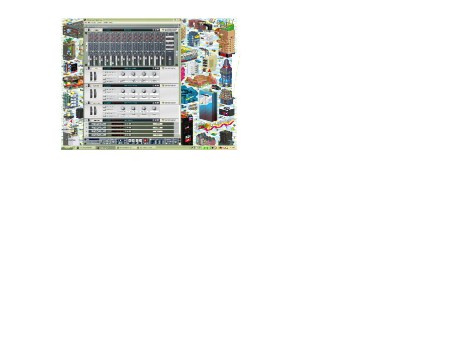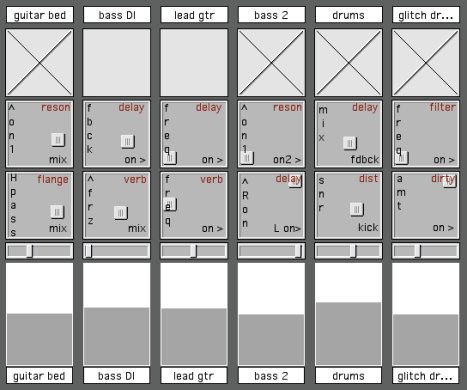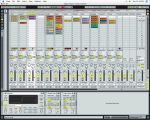1. Title: Bi-Coloured Suguri-Quartet (5:51)
2. Description: Bi-Coloured Suguri-Quartet is a medley of three songs from the game Suguri, done as if by a Saxophone Quartet. The song is 100% MIDI, crafted by hand alongside listening to repeated runs of the song multiple times. This listening strategy is similar to how I developed the drum track for Descadence, the second composition for this class. Each individual instrument was originally mapped to its own track, even if multiple such tracks would be addressed the same instrument in the end product. All the instruments were provided by my M-Audio KeyRig keyboard program, which is notedly a lot better for pianos than other instruments. But it still works well. While a drum track was created in the early stages of the work (you can see it hiding in the corner of the screenshots), it was abandoned in the decision for a quartet. I did not use any MIDI effects because while I experimented with the lot of them, I never was really happy with any besides Chord, which didn’t have a good place in this project.
The original inspiration of Bi-Coloured Suguri-Quartet was based on several pieces I happened to cross on my path while struggling on my initial idea, whose conception was so horrible it’s nightmarish to dare recall. One was a 10-minute medley of memetically popular songs, which made me consider doing a medley instead of sticking with some composition that I had no clear direction on. The second was a piece called “Touhou Ikaruga Style”, which was a remix of a song from one game done in the style of another. This was what inspired my original idea, to do the medley in the style of Ikaruga’s symphonic orchestras. This was complemented by my choice of songs belonging to the characters who use two colours of bullets, dichotomy being a strong theme in Ikaruga. As we figured out in class, though, this was not going to be feasible because getting the proper music samples to make a symphony was beyond the scope of a week’s worth of work. Trying to also decide on so many possible instruments made the task difficult. However, it struck me that the two characters for whom I medleyed songs from, are usually paired with two other characters. A quartet could easily be formed, and the instruments would each be assigned as if they were played by each character.
The choice for a Saxophone Quartet, with tambourine support, will be discussed under originality. Otherwise, to close the description, Bi-Coloured Suguri-Quartet is a medley that flows from Green Bird, to First Encount, back to Green Bird, straight to Rendevouz, and ending with First Encount. There is automation for volume to give focus on certain instruments over others, as the volume control on individual MIDI tracks was suspect at best. All the composition of the MIDI was done using the quantized grid by mouse, not keyboard. Notes were first composed based on the instrumentation of a section, and these were manipulated and repositioned to sound better (Saxophones shouldn’t hit C7 notes, at least as far as my ears could say). Since a drum track was abandoned for the lack of
3. Originality is an unusual thing to rate. On the one hand, this is a medley of existing music. The notes are not fully accurate (there’s a difference of one bar in the transition between the fourth and fifth parts, nevermind other differences in timing), but the song is, for all intents and purposes, constructed of existing material. In that sense, it is entirely inspired from the wonderful soundtrack of Suguri. But, without a doubt, the song is still original from many forms.
The selection of a Saxophone Quartet was inspired by the description I read of it. Beyond consisting of a Soprano Sax, an Alto Sax, a Tenor Sax, and a Baritone Sax or Bass Sax, the Saxophone Quartet’s other quality is its rarity in performance, as few groups that pursue record deals utilize such an arrangement. Thus, it was described that it’s a shame that its “unique sound” is not heard very often. So, this inspired me to take the song and, rather than seek some specific style, render it into its own unique sounding effect by creating it in a Saxophone Quartet. After all, that collection of four saxophones on the M-Audio KeyRig had been tempting for quite some time. Certainly, the song is unusual as a result. There’s only so much you can accomplish with a bunch of saxophones alone.
Saxophones have a notably different range of sounds that actually sound alright, compared to the vastness of a piano. Since I wrote most of the MIDI in piano (having learned that I could actually get those plinking sounds I wanted, I just had to go up more than two octaves), there was a lot of shifting up and down with the previously written MIDI to adjust for the saxophones. And, in some places, I decided to break the original flow of the song in favour of making the saxophones sound better, thus some of the drastic changes in pitch or tone in the original pieces were exchanged for much smaller gradients, or even in one place, a complete reversal of the original direction (from a rise to a fall).
The big note of the saxophone quartet was the lack of drums, so I opted to drop the drum track I had meticulously laboured on earlier. However, the Baritone Sax was apparently able to substitute in as a bass, so I used the Baritone Saxaphone as a bass/drum track. Without actual drums, of course. Since it is neither a bass nor a drum, though, I didn’t feel very happy simply duplicating the drum track into the saxophone. Instead, I wrote an original arrangement of notes for the bass track. This was actually very fun to do so, too, beyond being a nice additional flourish.
I didn’t stick with the quartet fully, though. I added a tambourine, which was present in the original drum track. This is because First Encount features a large amount of tambourine and maraca sounds in it, mimicking the fact that the character herself carries such instruments (albeit explosive). My maracas are at home but I did have tambourine samples. I thought that the addition of the tambourine would make the piece have more of a unique composition feel to it, add to the unusual aura it creates. As far as how it was played, for the most part the tambourine is always played when one of the players isn’t playing their saxophone. For the one point that it is, we can pretend it’s a kick-tambourine. On a stand. Yeah.
Overall, I’d rate myself as a 7 out of 10, 10 being fully original. While the songs are from a source, all of the MIDI was hand-crafted myself with no actual sheet music or guide beyond my ears. Additionally, the choice to combine them in the form of a Saxophone Quartet, and modify the songs as necessary to fit this decision, are forms of originality. A new bass track was completely written for this song, as was some very short tambourine sections. In the end, however, it is still a medley of existing songs, so no matter how much originality is expressed in the production, it’s still very much a derived work. 7/10, to restate.
4. As you can see from the screenshots, I’m extremely irresponsible and cannot actually focus on doing just work on the project, so I actually played Suguri constantly while composing. In a way, it helps understand the music better to be experiencing it as a rush of missiles or fiery tambourines to the face, and in another, it helps relieve stress.
While arrangement view is nice and all and allows you to view things in parallel, I started doing everything in session view and I intended to complete the project doing so.

This screenshot focuses on a section that I had to modify heavily from its original. The part highlighted was originally in the C7 range. Which, while sounding alright on a piano, does not sound like anything on a saxophone. Anything good, at any rate. Though the extreme difference in octave between that part, to me, was a crucial part of the original song’s work, I destroyed that difference in the name of a functional piece. Just to its right, you can also see the most annoying set of 32nd notes, crafted to make some kind of demonic archway in the name of an unusual roll on the piano. It never, ever sounded right when using the piano. For some reason, it didn’t sound half bad on the saxophone.

The Automation Screenshot is an example of how much automation I used. I considered more but for the most part, a lot of the song worked well without crazy pitch shifting and such. Volume automation was the full extent. The game looks fuzzy because it’s at the start of a slow-motion portion. The intimidation factor of this battle is totally lost with saxophones.
Another facet of the screenshot that’s visible is the array of instruments. While I narrowed the instruments down to only 4 from the potential massive it was before, I kept each track separate just to keep things easier to handle. Tracks end after they stop having more notes written, so they’ll grey out. The end will only have four tracks active, as all four Saxophones will be running. Oh, and the tambourine, too. The naming of the tracks is based on the names of the characters in the game or on what the sound felt like. Whatever fancy I had, really.
5. Links
Bi-Coloured Suguri-Quartet
This is the actual rendered file. AIF files are stupid huge, but I don’t really have an MP3 converter and no one else apparently listens to Ogg Vorbis. It is 5:51.
Selections from Green Bird, First Encount, and Rendevouz
This is a rendering of the original music played in the same sequence as the medley. Transitions are immediate, and of note, the piece is 5:50 in length. I shifted the medley back one bar between the fourth and fifth parts for flavourful matching, so the songs will desync at that point if you attempt to play them together.
Filed under: Final Project Postings | Leave a comment »









 ng problems posting audio files and screenshots. I’ve attached a screenshot with the linking and screenshot buttons highlighted. If this is still not clear, please consult with any other colleague who has been successful in his/her posting. thank you. If anyone is REALLY having problems, please call me at 917.576.6166… I don’t want you to have to miss the deadline for those sorts of reasons, and I’ll be staying up until 12.30 to be available should you need any assistance. To those who have already posted and done it completely, great job, congratulations. Todd
ng problems posting audio files and screenshots. I’ve attached a screenshot with the linking and screenshot buttons highlighted. If this is still not clear, please consult with any other colleague who has been successful in his/her posting. thank you. If anyone is REALLY having problems, please call me at 917.576.6166… I don’t want you to have to miss the deadline for those sorts of reasons, and I’ll be staying up until 12.30 to be available should you need any assistance. To those who have already posted and done it completely, great job, congratulations. Todd



